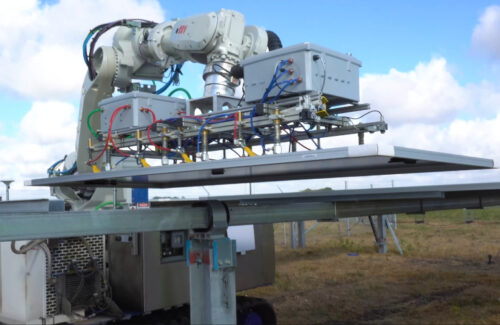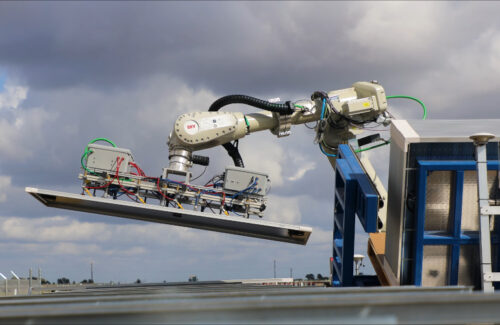Electrical contractor Rosendin will demonstrate its new autonomous robotic solution for solar module installation next week at an under-construction solar project in West Texas.
The three-piece robotic system features autonomous operations, obstacle detection and avoidance using lidar, maneuverability across uneven terrain and precise positioning of solar panels within 2 mm using GPS and KMZ mapping. The demonstration will show how electrical teams work alongside the robotic system to collaboratively install solar panels faster, safer and more efficiently. Field testing on a similar project in Danevang, Texas, achieved an installation rate equaling 400 modules per eight-hour shift with a two-man crew working collaboratively with the robots — three-times the rate of a standard four-person crew installing modules manually, Rosendin found.
“We created a solution that will revolutionize the installation of renewable energy facilities worldwide by providing a safer, faster, repeatable and more cost-effective means of deploying solar installations in remote locations,” said David Lincoln, Rosendin Senior Vice President. “Countless hours have been spent developing and testing the technology at utility-scale solar facilities, resulting in a robotics system that will assist electricians and reduce the risk of workforce injuries while addressing the construction industry’s decades-long workforce shortage.”
The gas- and battery-powered robots were developed by Rosendin in partnership with ULC Technologies. The working prototype was built to withstand environmental elements such as extreme temperatures, wind, rain, puddles, mud and uneven and rocky terrain up to a 30° incline.
The solution consists of a panel-setting robot featuring a tracked, construction-grade robotic platform with an integrated robotic arm and nine vacuum suction cups to lift and place solar panels. Two panel-carrying robots work together to transfer pallets of panels between the loading area and the installation point.
The Rosendin team in 2019 set out to build a solution to reduce physical strain on electrical workers. The collaborative robots offer both autonomous and manual operation via handheld controllers and can handle panels weighing 100 lbs while skilled electricians focus on grid connections.
“There are many applications for this technology. For example, using these robots, a developer can source new opportunities in geographical areas and markets that were previously considered too difficult to build,” said Lincoln. “The next iteration could even use a central control and monitoring system to run several robotic teams simultaneously that will enhance worker and job site safety, improve logistics, and provide cloud-based installation and movement data.”
Videos of the robots can be found online, and those interested in attending the demonstration event in Texas can find more information here.
News item from Rosendin





















